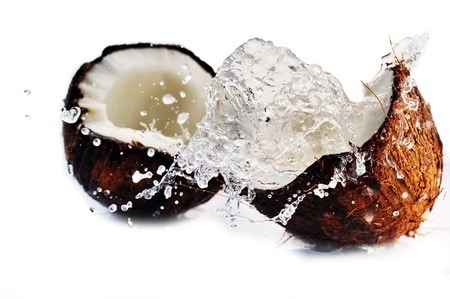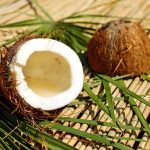
Many chefs and product developers rely on coconut milk as the base for that classic, the Thai green or red curry. We were interested, nay intrigued to know more about what it actually is and how its made given that it has become more expensive as there is often a shortage of coconuts through poor harvests. That can also be said for a related product called coconut water and it is quite common for chefs to confuse both products.
In this article we discuss both types and we also cover coconut milk powder.
Coconut Milk
Trawling through the recipe books for the Far East, coconut milk it is used in many traditional foods throughout Asia and the Pacific.
Coconut milk has a typical coconut aroma which is usually described as nutty and looks like a white waxy liquid. This is an emulsion stabilised by protein and ionic salts which have been found at the oil-water interface.
The milk lends a characteristic mildness and taste to Thai food which can be extremely hot from the amount and type of chili used. The main uses are as a base for not only curry but fish and shellfish dishes, confectionary, various meats and poultry, various beverages and serbhats.
When kept at ambient, coconut milk often separates because it is an emulsion which will then form two distinct phases – the heavy aqueous phase and a lighter creamy phase.
The flavour also deteriorates quickly at ambient temperature. The fats often go rancid. This is promoted by microorganism contamination and by light, additional heat and the presence of oxygen which causes fat oxidation. There is also some autoxidation too.
Composition Of Coconut Milk
Commercial coconut milk is a complex biological mix of fats, proteins, carbohydrates and minerals and appears as a milky white oil-in-water emulsion. The fat content varies between 15 and 40 % and is often altered to suit taste.
The milk is also a good source of several vitamins and minerals. One cup (240 grams) contains (1):
- Calories: 552
- Fat: 57 grams
- Protein: 5 grams
- Carbs: 13 grams
- Fiber: 5 grams
- Vitamin C: 11% of the RDI
- Folate: 10% of the RDI
- Iron: 22% of the RDI
- Magnesium: 22% of the RDI
- Potassium: 18% of the RDI
- Copper: 32% of the RDI
- Manganese: 110% of the RDI
- Selenium: 21% of the RDI
Flavour Compounds In Coconut Milk
The volatile compounds in coconut milk were measured using solid-phase microextraction and gas chromatography-mass spectrometry. Thirty-one volatile compounds are known. These are: lactones (34.4%), esters (31.5%), aldehydes (20.0%), acids (3.8%), ketones (2.3%), alcohols (1.4%) and other (0.6%).
One compound of note is delta-octalactone (Wang et al., 2020).
Preparation Of Coconut Milk
Milk is prepared as the grated flesh of coconut which is the endosperm of the ‘nut’.
This flesh is steeped in hot water or heated milk and then sieved.
Three classifications are available – a cream, a thick and thin form. Initially during processing, ‘thick’ coconut milk is formed by soaking then squeezing. When the milk is cooled to below 8 °C, the top layer forms a fatty cream which is skimmed off as a separate ingredient. The remaining liquor paste is soaked and squeezed a second time, then sieved a second time to form the thin milk. To improve mouthfeel, extra stabilisers and emulsifiers can be added, and the fat content is adjusted as required before the emulsion is stabilised further by homogenisation.
Canning is the most suitable method for storing the milk, usually relying on retort sterilisation. The alternative is continuous pasteurisation through plate heat exchangers, heated to between 72 to 75°C for 20 mins (Seow and Gwee, 1997) before filling into mainly cans, boxes or soft plastic bags. The powder which can be a convenient form for the chef is generated by spray-drying. Freezing the milk causes emulsion break yielding coconut oil (Cancel, 1979; Gonzalez, 1990).
High Pressure Processing is now being tried as a way to keep the green notes and freshness of the product (Ruengdech & Siripatrawan, 2021).
Problems can occur if the processing is not quite right. At high temperature on pasteurisation or storage, the milk can separate further. The rheological properties can alter significantly and the proteins in the emulsions denature to leave a fouling deposit on the pasteurisation plates for example. Fouling is commonplace during processing but has been extensively investigated (Pichitvittayakarm et al., 2006; Law et al., 2009) to understand how to minimise the issue.
Coconut Milk Powder
Most coconut milk powder is obtained by spray drying the coconut milk extract. It is highly problematic because of the high fat content in the milk.
.
Coconut Water
This appears one of the most exciting innovations for coconuts (Cocos nucifera L.), because of its nutritional content and has certainly become a very trendy drink, although there is scepticism in the popular press for its claimed properties. Unlike the milk, this is the natural liquid obtained from green or unripe coconuts which usually makes them less than 6 months old, and is in fact the liquid endosperm of the coconut (Caplin and Steward, 1948, 1949). The water makes up 18% of the mature coconut (Assa et al., 2010). It has special properties in the plant because it was found to induce mature, non-growing cells to divide and grow rapidly. The liquid is isotonic in composition compared to human blood and thus has potential hydration benefits which makes it suitable for sports and strenuous muscle related activities (Ismail et al., 2007). It was also used successfully as an intravenous drip (Campbell-Falck et al., 2000).
It has a characteristic flavour being slightly sweet and acidic and its volatile composition has been defined too (Borse et al., 2007). It is also low in carbohydrates, virtually no fat or cholesterol and a source of both potassium, magnesium, some sodium and calcium (Jirovets et al., 2003; Chumbimuni-Torres and Kubota, 2006). It is a useful product development base for use with other fruit juices.
Nutritional Content Of Coconut Water
| Table 1 Fresh, coconut water. (Ref:USDA National Nutrient data base) | ||
| Principle | Nutrient Value/100g | Percentage of RDA |
| Energy | 19 Kcal | 1% |
| Carbohydrates | 3.71 g | 3% |
| Protein | 0.72 g | 1.5% |
| Total Fat | 0.20 g | 1% |
| Cholesterol | 0 mg | 0% |
| Dietary Fiber | 1.1 g | 3% |
| Vitamins | ||
| Folates | 3 µg | 0.75% |
| Niacin | 0.080 mg | 0.5% |
| Pantothenic acid | 0.043 mg | <1% |
| Pyridoxine | 0.032 mg | 2.5% |
| Riboflavin | 0.057 mg | 4% |
| Thiamin | 0.030 mg | 2.5% |
| Vitamin C | 2.4 mg | 4% |
| Vitamin A | 0 IU | 0% |
| Vitamin E | 0 mg | 0% |
| Vitamin K | 0 mcg | 0% |
| Electrolytes | ||
| Sodium | 105 mg | 7% |
| Potassium | 250 mg | 5% |
| Minerals | ||
| Calcium | 24 mg | 2.4% |
| Copper | 40 mcg | 4.5% |
| Iron | 0.29 mg | 3.5% |
| Magnesium | 25 mg | 6% |
| Manganese | 0.142 mg | % |
| Zinc | 0.10 mg | 1% |
| Phyto-nutrients | ||
| Auxin (Gibberlin) | Present | — |
| Carotene,ß | 0 µg | — |
| Cytokines | Present | — |
| Lutein-zeaxanthin | 0 µg | — |
| Leucoanthocyanin | Present | — |
Obtaining Coconut Water
One difficulty has been sourcing coconut water at the appropriate maturity and the method is very much based on local expertise. I noticed that recent research activity relying a measurements of dissolved oxygen activity has been tested in Mexico to discriminate between husks of varying age (Hahn, 2012)
A significant processing issue with coconut water is microbial contamination. Any deviation from good practice and fermentation becomes an issue. In some cases, the water produces particulates which occur when membrane filtration has not been applied or when protein-polyphenol hazes form. Methods to overcome these issues can be discussed with the author.
I have found a couple of suppliers in local supermarkets. I suspect that part of the issue with this product has been the quality of the processing and subsequent packaging. The packaging is largely in TetraPak cartons which suggests a form of aseptic processing is required to maintain longevity of the product. VitaCoco which market a coconut water beverage claimed to have made a $110 million brand in the USA whilst Green Coco have $65 million worth of sales in Europe based on in-house data. The supplier iTi Tropicals (www.itiTropicals.com) provides a concentrate which has been used to soften the flavour profile of more tart fruit juices. Coconut water also has antioxidant properties (Leong and Shui, 2002) but this disappears on processing, chemical processing and with maturation of the coconut.
Whatever the issues of processing, coconut milk will continue to be a welcome base for many curries and many years to come. Also, coconut water appears to offer some new alternatives for the product developer with some useful nutritional offerings.
Incidentally coconut milk is ideal for vegans and those with gluten intolerance.
Products:
If you just keen on coconut milk then we tend to use the Blue Dragon™ brand which comes in a handy 400ml tin can. CocoMojo™ – a whole coconut milk and water beverage with botanicals, herbs, fruits and spices (http://drinkcocomojo.com/) in a cardboard tubular carton.
Please note we are linked to affiliate marketing sites where we hope to make some commission to keep the web-site operating. Please read our affiliate disclosure.
References
Assa, R., Konan, J., Prades, A., Nemlin, J., Koffi, E. (2010) Physicochemical characteristics of kernel during fruit maturation of four coconut cultivars (Cocos nucifera L.). Afr. J. Biotechnol. 9(4) pp. 2136-2144
Borse, B.B., Rao, L.J.M., Ramalakshmi, K., Raghavan, B. (2007) Chemical composition of volatiles from coconut sap (neera) and effect of processing. Food Chem., 101 pp. 877-880.
Campbell-Falck, D., Thomas, T., Falck, T.M., Tutuo, N., Clem, K.(2000) The intravenous use of coconut water. Am. J. Emerg. Med. 18 pp. 108-111.
Cancel, L. E. (1979). Coconut food products and bases. In J. G. Woodroof (Ed.), Coconuts: Production, processing, products Westport, Connecticut: AVI Publishing. pp. 202-239
Caplin, S.M., Steward, F.C. (1948) Effect of coconut milk on the growth of explants from carrot root. Science 108 pp. 655-657
__________________________ (1949) A technique for the controlled growth of excised plant tissue in liquid media under aseptic conditions. Nature 162 pp. 920-925
Chumbimuni-Torres, K.Y., Kubota, L.T. (2006) Simultaneous determination of calcium and potassium in coconut water by a flow-injection method with tubular potentiometric sensors. J. Food Comp. Anal., 19 pp. 225-230
Gonzalez, O. N. (1990). Coconut milk. In: J. A. Banzon, O. N. Gonzalez, S. Y. de Leon, & P. C. Sanchez (Eds.), Coconut as food Quezon City, Philippines: Philippine Coconut Research and Development Foundation. pp. 15-48
Hahn, F. (2012) An on-line detector for efficiently sorting coconut water at four stages of maturity. Biosystems Eng., 111 pp. 49-56
Jirovetz, L., Buchbauer, G., Ngassoum, M.B. (2003) Solid-phasemicroextraction-headspace aroma compounds of coconut (Cocos nucifera) milk and meat from Cameroon. Ernahrung Nutr. 27 pp. 300-303
Ismail, I. (2007) Rehydration with sodium-enriched coconut water after exercise-induced dehydration. Southeast Asian J Trop Med Public Health. 38(4) pp. 769-85
Law, H.Y., Ong, C.I., Aziz, N.A., Taip, F.S. Muda, N. (2009) Preliminary Work On Coconut Milk Fouling Deposits Study. Int. J. Eng. Technol. IJET 9 (10) pp. 18- 23 (Article)
Leong, L.P., Shui, G. (2002) An investigation of antioxidant capacity of fruits in Singapore markets. Food Chem., 76 pp. 69-75
Mantena, S.K., Jagadish, Badduri, S.R., Siripurapu, K.B., Unnikrishnan, M.K. (2003) In vitro evaluation of antioxidant properties of Cocos nucifera (Linn.) water. Nahrung 47 pp. 126-131
Pichitvittayakarm, W., Narataruksa, P., Heggs, P.J. and Tia, S.(2006) Effects of fluid flowrate on coconut milk fouling at pasteurization temperature (70ºC – 74.5ºC) Songklanakarin J. Sci. Technol., 28 ( 6) pp. 1275-1288
Ruengdech, A., & Siripatrawan, U. (2021). Application of catechin nanoencapsulation with enhanced antioxidant activity in high pressure processed catechin-fortified coconut milk. LWT, 140, 110594 (Article).
Seow, C.C. and Gwee, C.N. (1997) Review, coconut milk: chemistry and technology. J. Food Sci. Tech., 32 pp. 189-201
Wang, W., Chen, H., Ke, D., Chen, W., Zhong, Q., Chen, W., & Yun, Y. H. (2020). Effect of sterilization and storage on volatile compounds, sensory properties and physicochemical properties of coconut milk. Microchemical Journal, 153, 104532.
Revised: 4th August 2021.. additional material added.


Coconut milk comes across as a bit disappointing at times because it doesn’t always have the flavour I’m after. I’ve been using organic types to get that real authentic curry note. I’m always surprised at how the coconut milk has all the really creamy part stuck to one end of the tin. The fat reduced stuff always seems to produce a slimy curry feel by the way. Thought you ought to know.